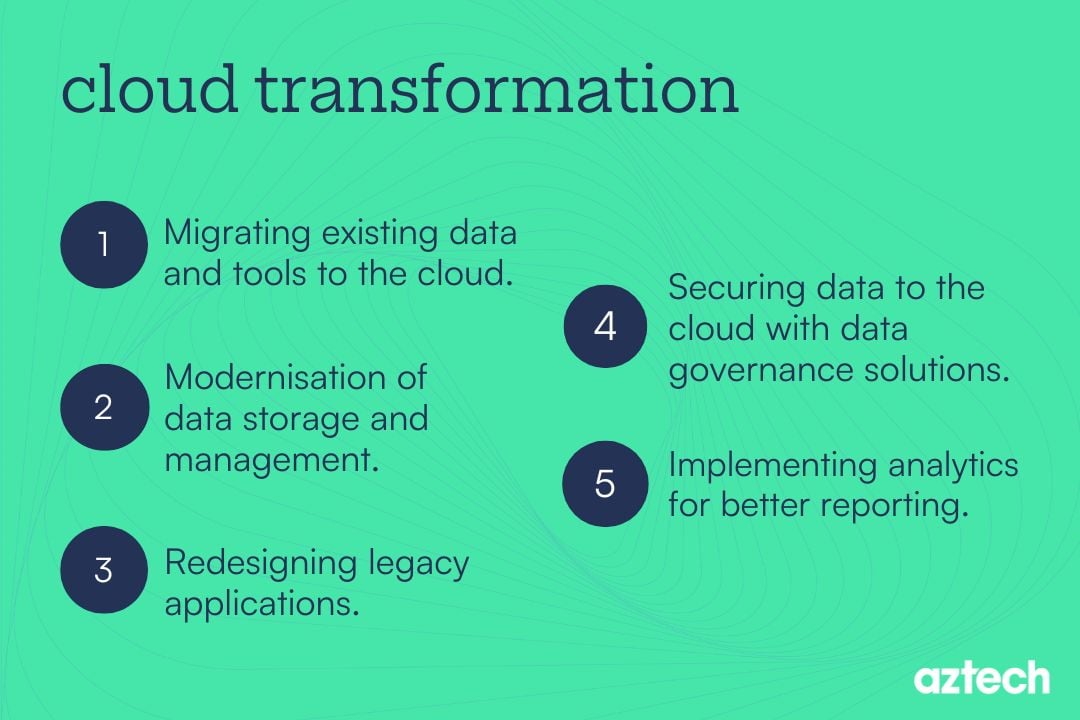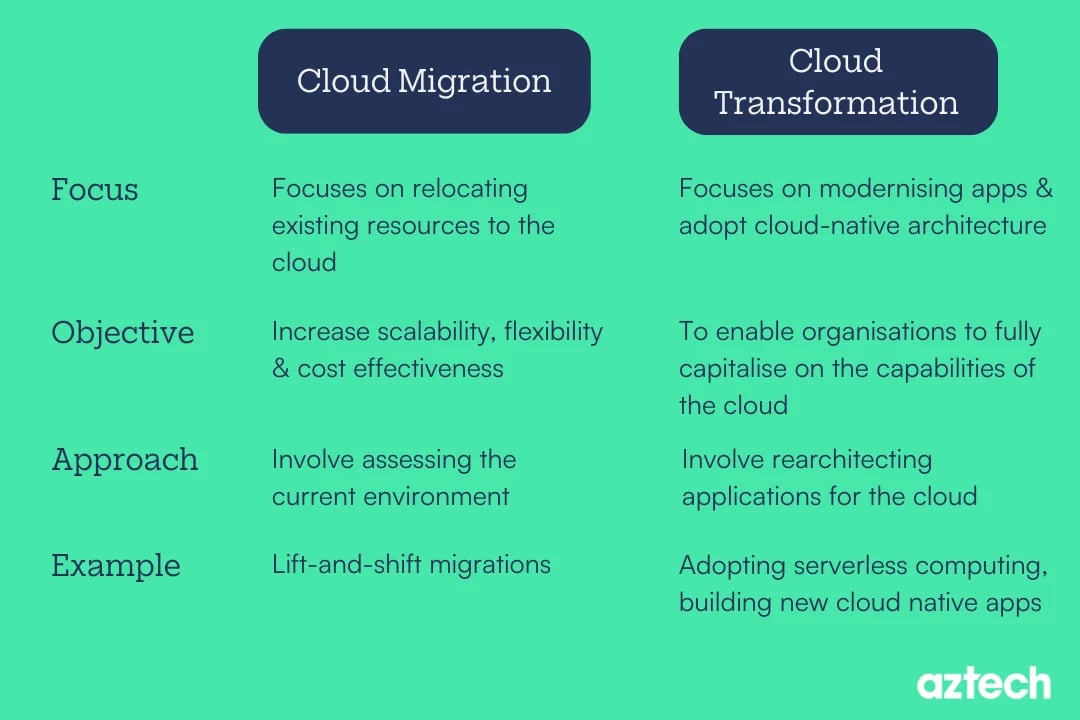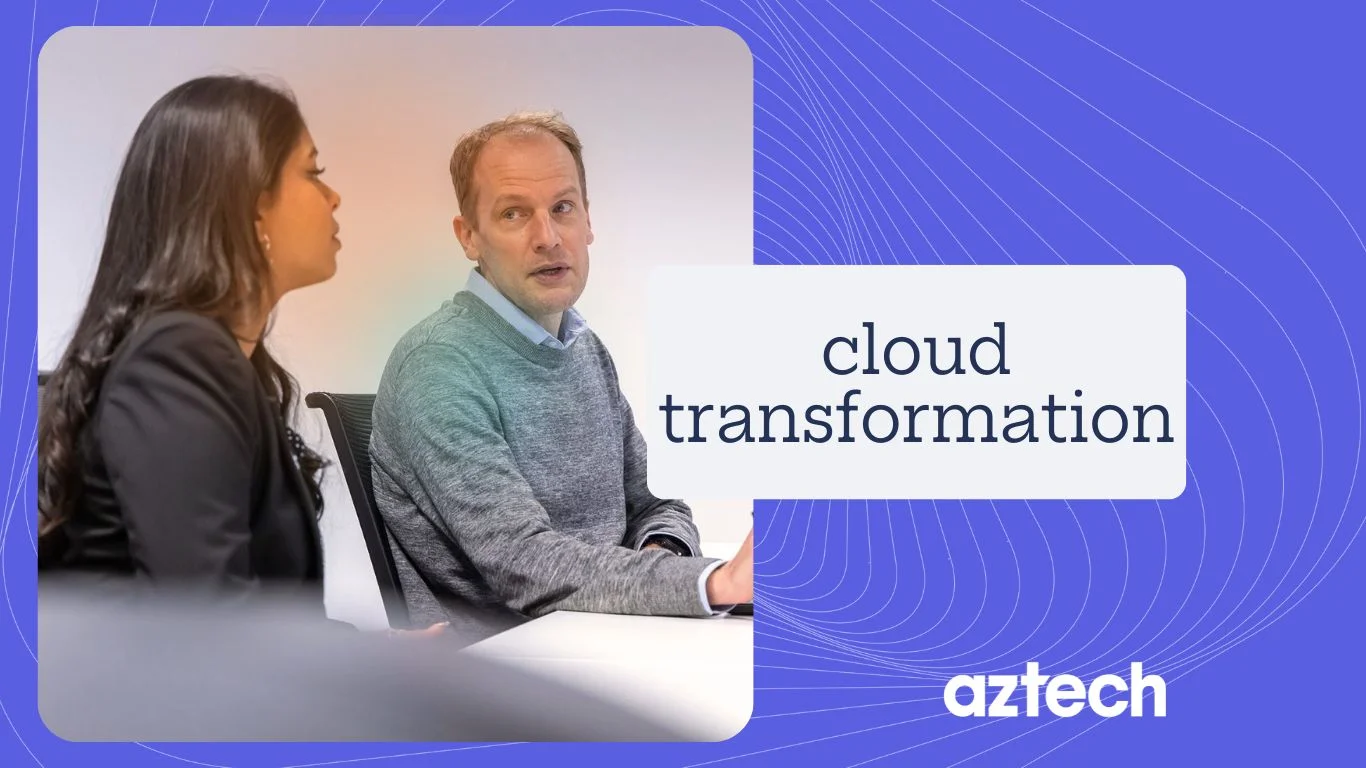Have you considered the benefits of cloud transformation for enhancing your business continuity? If not, don't worry.
Today, we will delve into the advantages of cloud services and how embarking on a digital transformation journey can give your business a competitive edge.
Gartner has forecasted that by 2024, GenAI tools will be harnessed to clarify outdated business applications and develop suitable alternatives, leading to a 70% decrease in modernisation expenses by 2027.
Additionally, Google announced the opening of a new cloud data centre in the UK, to keep up with the increasing demand for artificial intelligence in 2024.
One of the most profound shifts in recent years has been the widespread adoption of cloud service providers like AWS, Microsoft Azure, and Google Cloud.
Cloud transformation has emerged as a strategic imperative for organisations looking to leverage the power of the cloud to drive efficiency, innovation, and growth.
In this blog post, we will explore what cloud transformation is, the stages of cloud operations, its benefits and challenges, and how you can develop a successful transformation strategy.
Accelerating cloud transformation with Microsoft and Oracle
What is Cloud Transformation?
Cloud transformation is the process of migrating an organisation's IT infrastructure, applications, software programs and business data to the cloud.
It involves reimagining and redesigning business strategies, processes and operations to fully capitalise on the benefits of cloud computing.

Some common use cases and examples of cloud transformation include:
-
Migrating existing data and tools to the cloud
-
Modernisation of data storage and management
-
Redesigning legacy applications
-
Securing data to the cloud with data governance solutions
-
Implementing analytics for better reporting
What are the Benefits of Cloud Transformation?
Cloud transformation offers a wide range of benefits for your business which include:
1. Scalability
Cloud environments allow organisations to scale their IT resources up or down as needed, enabling them to accommodate fluctuating demand and avoid overprovisioning.
2. Cost Savings
By eliminating the need for on-premises infrastructure and reducing IT maintenance overheads, cloud platforms can lead to significant cost savings for businesses.
3. Flexibility
Cloud environments offer greater flexibility and agility compared to traditional infrastructure, allowing organisations to adapt quickly to changing business requirements.
4. Innovation
Cloud computing provides access to new technologies such as artificial intelligence, machine learning, and big data analytics, enabling organisations to drive innovation and stay ahead of the competition.
5. Improved Collaboration
Cloud-based collaboration tools enable employees to work together more effectively, regardless of their location, leading to improved productivity and collaboration.
Stages of Cloud Transformation Roadmap
A successful cloud transformation involves several key stages which include:
1. Assessment and Planning
Firstly, organisations have to assess their existing physical infrastructure, applications, and data to determine their readiness for cloud migration.
Also, businesses can develop a comprehensive cloud transformation strategy to guide the whole migration process.
2. Migration
This stage involves moving workloads and applications and seamlessly transitioning their business data from on-premises infrastructure to the cloud.
Organisations may choose to migrate their foundational services and computing resources and entire IT environment at once or adopt a phased approach.
3. Optimisation
Once the initial migration is completed, organisations need to optimise their cloud environment to maximise performance, scalability, and cost-efficiency.
This may involve fine-tuning applications, implementing automation tools, and optimising resource allocation.
4. Governance and Cloud Security
The success of cloud transformation depends on the security of the cloud. Therefore, it is important to prioritise cloud security as a fundamental aspect of your overall business strategy.
So, implementing a robust data governance solution and cloud security measures will ensure compliance with regulatory requirements, protect data privacy, and mitigate data breaches in the cloud.
5. Focus on Innovation
With their IT infrastructure hosted on the cloud, organisations can focus on driving innovation and business transformation.
They can experiment with new innovative technologies, develop digital technology, and match customer demand more quickly and efficiently.
What are the Risks & Challenges Associated with Cloud Transformation?
While cloud transformation offers many benefits, it also presents several challenges and risks for organisations which include:
1. Security Concerns
Security is a major concern for organisations moving to the cloud, as they must ensure that sensitive data is protected from unauthorised access and any new security threats.
2. Compliance Issues
Organisations operating in regulated industries must ensure that their cloud environment complies with industry regulations and data protection laws.
3. Legacy Systems Integration
Integrating legacy systems with cloud-based applications can be challenging and may require significant time and resources.
4. Skill Gaps
Cloud transformation requires specialised skills and expertise, which may be lacking within the organisation. Organisations may need to invest in training or hire external talent to bridge the skill gap.
5. Data Migration
Migrating large volumes of data to the cloud can be complex and time-consuming, especially for organisations with legacy systems and outdated data formats.
How to Develop a Cloud Transformation Strategy?
Developing a comprehensive business strategy is essential for ensuring a successful migration to the cloud.
Here are some key steps to consider for your cloud transformation strategy:
Step #1: Assessment of Current State
Organisations should conduct a thorough assessment of their current IT infrastructure, applications, technology compatibility and data.
Also, they should identify their existing pain points, inefficiencies, and areas for improvement. Finally, companies should evaluate the readiness of their systems and business processes for migration to the cloud.
Step #2: Define Clear Objectives and Goals
In the next step, organisations should set clear and specific objectives for their cloud transformation initiative and align those objectives with their overall business goals and strategic priorities.
Also, you should define measurable key performance indicators (KPIs) to track the progress and success of your cloud transformation journey.
Step #3: Choose the Right Cloud Model
In this step, you should determine which cloud model (public, private, or hybrid) best suits your organisation's needs and requirements.
You should consider factors such as data sensitivity, regulatory compliance, performance requirements, and cost.
Also, choose industry cloud service providers that offer the necessary features, capabilities, and support to achieve your business goals.
Step #4: Develop a Migration Plan
In this step, you need to develop a detailed migration plan outlining the steps, timelines, and resources required for migrating your IT environment to the cloud.
For this, identify which workloads, applications, and data will be migrated first, and prioritise them based on business criticality and complexity.
Also, consider adopting a phased approach to migration, starting with less critical workloads, and gradually scaling up to more mission-critical systems.
Step #5: Address Security and Compliance
In this step, you should implement robust security measures to protect sensitive data and ensure compliance with industry regulations and data protection laws.
In addition, organisations must encrypt corporate data in transit and at rest, implement access controls and authentication, and regularly monitor for security threats and vulnerabilities using features such as vulnerability scanning, security analytics, and log collection.
Also, you should establish a data governance solution to ensure proper data management, privacy, and compliance with regulatory requirements.
Step #6: Train Your Team
Provide comprehensive training and support to your IT team on digital transformation to ensure they have the skills and expertise needed to manage and optimise your cloud strategy effectively.
In addition, invest in any ongoing training and cloud transformation programmes to keep your team up to date with the latest digital transformation programmes, best practices, and security standards.
Also, encourage a culture of continuous learning, experimentation, and digital innovation to contribute to cloud technologies within your organisation.
Step #7: Monitor and Optimise
In this step, you should continuously monitor the performance, security, and cost of your cloud environment.
In addition, use cloud monitoring and management tools to track resource utilisation, identify bottlenecks, and optimise performance.
Regularly review your cloud usage and spending patterns to identify opportunities for cost optimisation and efficiency improvements.
Also, implement automation and orchestration tools to streamline operational processes and minimise manual intervention.
Step #8: Engage Stakeholders
Organisations should involve key stakeholders from across the organisation in the cloud transformation process. Build consensus and alignment around the cloud transformation strategy and objectives.
Also, Communicate regularly with stakeholders to keep them informed of progress, challenges, and successes.
Finally, solicit feedback and input from stakeholders to ensure that their needs and requirements are addressed throughout the cloud transformation journey.
Step #9: Iterate and Adapt
To achieve success in cloud transformation, it's important to adopt an agile and assertive approach. You should continuously assess and refine your strategy based on feedback and changing business needs.
Also, you should be flexible in responding to evolving digital technologies and customer demands.
It's essential to foster a culture of innovation and continuous improvement to drive ongoing success and customer experiences and value from your cloud transformation efforts.
Cloud Transformation vs. Cloud Migration

Cloud migration involves moving existing workloads, applications, and data stored from on-premise infrastructure to the cloud, whereas cloud transformation involves reimagining and redesigning business processes, business operations, and strategies to fully leverage the benefits of cloud computing.
Cloud Migration
Focus: Cloud migration primarily focuses on relocating existing resources to the cloud while maintaining their functionality, performance, and security.
Objective: The goal of cloud migration is to leverage the scalability, flexibility, and cost-effectiveness of cloud computing without necessarily making significant changes to the existing applications or workflows.
Approach: Migration projects typically involve assessing the current environment, planning the migration strategy, executing the migration process, and then optimising and managing the cloud-based resources post-migration.
Examples: Lift-and-shift migrations, where applications are moved to the cloud with minimal modifications, are common examples of cloud migration projects.
Cloud Transformation
Focus: Cloud transformation focuses not only on moving existing workloads to the cloud, but also on modernising applications, adopting cloud-native architectures, and transforming business processes.
Objective: The goal of cloud transformation is to enable organisations to fully capitalise on the capabilities of the cloud, such as microservices, serverless computing, DevOps practices, big data analytics, and artificial intelligence.
Approach: Cloud transformation initiatives typically involve rearchitecting applications for the cloud, developing new cloud-native applications, implementing agile and DevOps methodologies, and integrating cloud services into the organisation's workflows.
Examples: Refactoring monolithic applications into microservices, building new cloud-native applications, adopting serverless computing, implementing continuous integration and continuous delivery (CI/CD) pipelines, and using cloud-based AI and machine learning services are examples of cloud transformation activities.
How Aztech Can Help as a Cloud Provider to Accelerate Your Cloud Journey?
At Aztech, we specialise in helping organisations accelerate their cloud transformation journeys.
Our team of experts can provide cloud services with end-to-end support, from initial assessment and planning to migration, optimisation, and ongoing management of your digital transformation journey.
We offer a full range of cloud services, including consulting, migration, and managed cloud services, to help you focus on developing a business domain adoption loop and building foundational capabilities.
Furthermore, you can unlock the full potential of the cloud and create new business models which drive digital innovation, efficiency, and growth aligned with your business goals.
Conclusion
Cloud transformation is not just about migrating to the cloud; it's about reimagining and redesigning your business models to thrive with digital technologies.
By embracing cloud technology, organisations can unlock new opportunities for innovation, efficiency, and growth while staying agile and competitive in today's rapidly evolving market.
With the right cloud hosting platform, risk management best practices, and support from experienced cloud providers like Aztech, you can successfully navigate cloud capabilities and realise the full benefits of cloud transformation.
Feel free to reach out to us for any enquiries about cloud solutions.

-1.png?width=552&height=678&name=text-image%20module%20desktop%20(4)-1.png)


.png?width=2000&name=Case%20study%20(21).png)


-2.png?width=422&height=591&name=text%20image%20tablet%20(31)-2.png)

-2.png?width=1366&height=768&name=Blog%20Hero%20Banners%20(4)-2.png)
-2.png?width=1366&height=768&name=Blog%20Hero%20Banners%20(5)-2.png)




